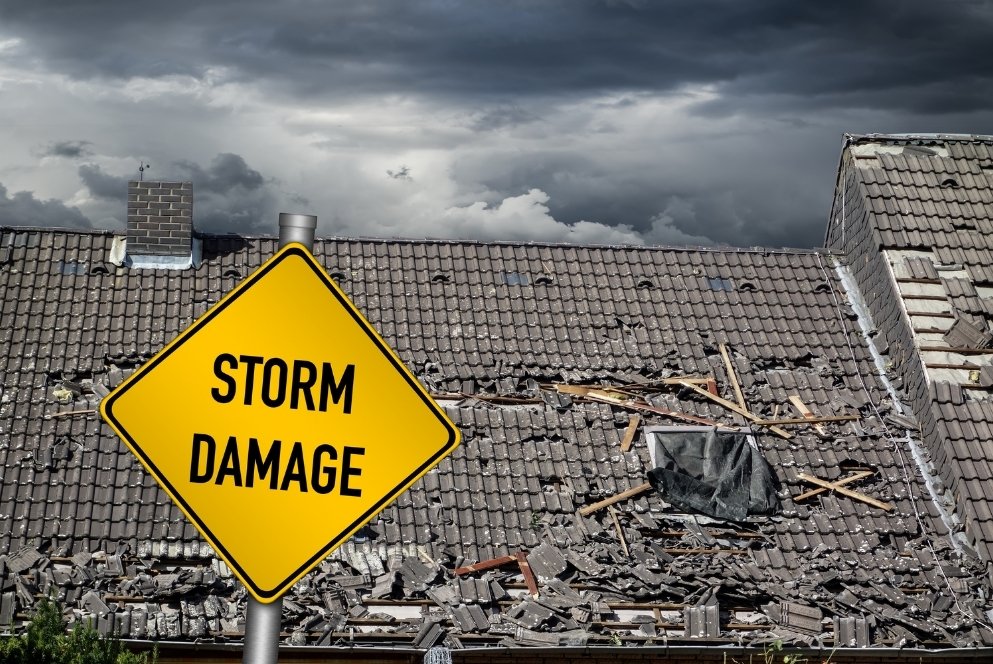Anyone who owns a home knows there’s potential for storms to cause damage to their roof. In some cases, this damage can be significant, while other types may not be readily apparent. It’s essential to know the signs of wind damage so that the homeowner can have it properly inspected and repaired. Wind damage left without the necessary attention can cause extensive damage to the home’s internal structure.
Do you Need a Storm Damage Inspection?
When Should You be Concerned About Wind Damage?
There are many instances where a homeowner should be concerned about potential wind damage. One of the most common cases in which wind damage, both major and minor, could occur is during a severe thunderstorm. These storms produce winds above 60+ mph and easily dislodge shingles, lift edges, or blow off entire roof sections. Winds lower than 60 mph can do damage. Any storm with winds over 50 mph can cause some damage.
Severe thunderstorms can produce another phenomenon called straight-line winds, which produce powerful bursts of wind in a singular direction that can mimic the damage caused by a small tornado. These types of winds happen randomly during the thunderstorm and are capable of considerable damage in isolated areas. Some straight-line wind damage can lift entire sections of the roof from the structure, but even minor damage must be repaired as soon as possible to prevent water and pests from entering the structure.
Another threat homeowners should be concerned about is tornado damage. These types of natural disasters also occur with severe storms and can develop quickly without much warning. Tornadoes can happen during most months of the year and depending on how powerful the tornado is, it may cause significant damage. Even homes on the damage path’s outskirts may have missing shingles, missing sections, or other forms of damage that require immediate attention. Always have your roof inspected for damage if a tornado was confirmed nearby to help prevent further potential problems with the roof.
Residents living on or near coastal areas from Texas to Maine must also concern themselves with hurricanes’ damage. These massive, powerful storms are known for creating widespread roof damage. Even a category one hurricane can produce varying degrees of damage that must be repaired as soon as possible to prevent further damage to the structure, which is why an inspection is an excellent idea after the storm passes.
Accessing Roof Damage and Seeking Repairs
It’s important to know that even seemingly minor roof issues can create further damage and deterioration over a short time frame. A small hole in a roof or missing shingles can allow water to seep into the roof and ruin the surrounding materials. When water leaks into a home, it ruins the walls, electrical wiring, and insulation. In more severe cases, roof damage can destroy a home.
If you see any water leaking from the ceiling or spots where to roof is discolored, especially after heavy rain or storm, you should be concerned with roof damage. Leaking water is a tell-tale sign that damage has likely occurred and has begun to affect the structure or home’s integrity. Additionally, roof damage can cause paint to bubble out and fill with water, which can be a concern for the walls of the house and the insulation, sheetrock, and wiring. This type of damage is an immediate threat and needs professional attention. Keep in mind that leaks from the roof also cause mold to grow, which causes extreme health hazards for all who live or visit the home.
Homeowners must address any roof damages immediately to get the best outcome. The first step is to have a licensed and reputable roofing contractor inspect the damage to provide insight regarding the proper approach to repairs and the amount of work involved. They can quickly arrive to inspect using top professional equipment and insight to provide an estimate of services and an approximate timeline for repair completion.
Once the repairs’ scope is determined, the homeowner can provide the details and information to their insurance company to begin the process and get the fastest results. Most professional roofing contractors will work well with most insurance companies to make the process easier for everyone.
Anyone suspecting damage to their roof should take action right away to protect their home and their health. Call a contractor to provide an assessment and an estimate to understand the scope of services necessary. Be sure to contact your insurance company and submit any documentation from the contractor for approval before beginning the process of repairs.
